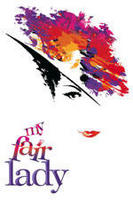
In looking for some theater fun this summer, I auditioned for and was cast in a local production of My Fair Lady. Let me be plain: most musicals done by community theater groups are sexist (and often racist) drivel, and I sometimes cringe before, during, and after auditions. Once in the show, I go with the spirit of adventure, fun, and exhibitionism, but, as a feminist, I still do feel occasional moments of embarrassment or shame at being part of such status quo fare.
When I did Adelaide in Guys and Dolls in 2001, I relatively easily convinced myself that so much parody was going on that I need not worry. At worst, Adelaide is a “doll” of her time, strong and independent in spirit but desiring to be a married and “respectable” woman, too. And with a lead role and five songs in the show, I had a superb time with the entertaining cartoon that is Adelaide.
Last year I auditioned for South Pacific with great reservations. “Bali Hai” is a beautiful song, but reconciling myself to the racist mess that is Bloody Mary was not easy. When I auditioned and was asked by the director to heighten my sing-song pseudo-Asian accent, I cringed. That I did not get cast in the role was ultimately a blessing. Though I could find my way inside Bloody Mary to portray her as a woman working within the racist/sexist system of the U.S. military to do the best she could financially for herself and her daughter, I was glad not to have to deal with it (or convince the director to let me play it so). Yes, the show does deal overtly with bigotry enough to argue for tolerance, but the closest it gets is that the white woman’s white boyfriend had a former native lover (mother of his children). Our heroine need not sully herself by actually getting involved with a person of color. Heaven forbid! Just raise up the little colored young’uns. (I was offered the part of the Head Nurse, so that pleased my ego—but I ultimately decided I just didn’t want to be part of that show.)
Then, this summer, along comes My Fair Lady: the story of the flower “girl” who is molded by the stodgy professor into an upper-class lady. Even when he treats her shoddily, she ultimately comes back for more. Not exactly feminist fare. Nonetheless, I was cast as Mrs. Higgins, she who condemns her son’s coldness and cheers on Eliza Doolittle for helping her boy to truly feel something for someone else. Of course, that Henry turned out to be such a prick may be laid on his mother’s shoulders, especially if Freud has any say in our interpretation. Yet, I do enjoy several of my lines, including my quip that if I were Eliza I would not have thrown his slippers at him but the fire irons. I am playing the role with more than a touch of Aunt Agatha from the Jeeves and Wooster stories, and the accent is delightful fun.
Now, I have friends who suggest that we can read Eliza’s decision to return to Higgins differently (this ending, of course, differs from the original G.B. Shaw play, Pygmalion, in which Eliza leaves him and runs off to marry — and financially support – the upper-class twit Freddy). They read it as consensual kinkiness: the two of them like their dominant-submissive relationship the way it is.
But now some of my castmates and I have decided something else as we’ve watched the show unfold in rehearsal: Higgins is gay. A gay stereotype, to be sure, but stereotypes are what you get in the majority of musicals. He is deeply afraid of women, and Eliza figures this out and the two of them do their dance and Higgins realizes he need not even have sex with her but can just have her as a companion and convince himself he’s not gay. This leads to wondering what Eliza gets out of it. Respectability and someone to pay her bills, I guess, which ain’t hay. As she says, she’s always been able to get men to like her “in that way.” Higgins is something new…and a man of means.


1 comment:
I found your insights on "My Fair Lady" interesting. I never thought of Higgins and Eliza's relationship as a covering for Higgins' homosexuality.
But more so those on "South Pacific", I disagree with your reading of the play. Primarily due to the songs "You have to be taught" and "My girl back home" which show how the characters relate to their own racism and the racism in their society. And I agree that the character "Bloody Mary" is a merchant who is trying to break her daughter out of the world that she herself was entrapped.
Your critique of the current state of local theater I can not speak of, but I will have to defend Rodgers' and Hammerstein's score and book.
Thanks for making me think (again)!
Post a Comment